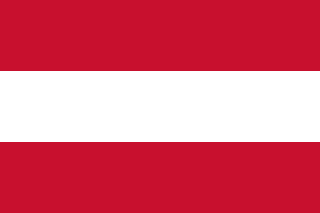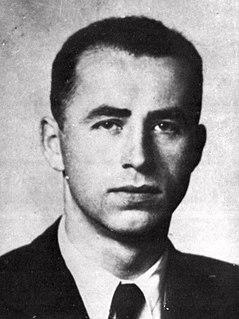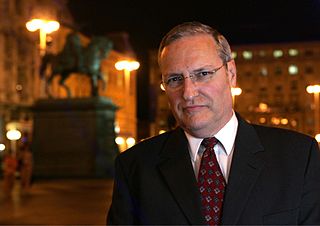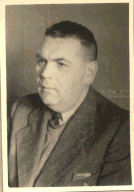
The Jewish Historical Documentation Centre (Zentrum für jüdische historische Dokumentation) was an office headed by Simon Wiesenthal in Linz. The centre collected and promulgated information about war crimes, specific mainly to crimes against the Jewish people as perpetrated by the Nazi Regime in Europe during the Second World War.

Simon Wiesenthal was a Jewish Austrian Holocaust survivor, Nazi hunter, and writer. He studied architecture and was living in Lwów at the outbreak of World War II. He survived the Janowska concentration camp, the Kraków-Płaszów concentration camp, the Gross-Rosen concentration camp, a death march to Chemnitz, Buchenwald, and the Mauthausen-Gusen concentration camp.

Linz is the third-largest city of Austria and capital of the state of Upper Austria. It is in the north centre of Austria, approximately 30 kilometres south of the Czech border, on both sides of the River Danube. The population of the city is 204,846, and that of the Greater Linz conurbation is about 789,811.
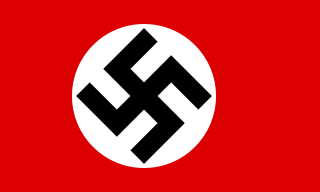
Nazi Germany is the common English name for Germany between 1933 and 1945, when Adolf Hitler and his Nazi Party (NSDAP) controlled the country through a dictatorship. Under Hitler's rule, Germany was transformed into a totalitarian state that controlled nearly all aspects of life via the Gleichschaltung legal process. The official name of the state was Deutsches Reich until 1943 and Großdeutsches Reich from 1943 to 1945. Nazi Germany is also known as the Third Reich, meaning "Third Realm" or "Third Empire", the first two being the Holy Roman Empire (800–1806) and the German Empire (1871–1918). The Nazi regime ended after the Allies defeated Germany in May 1945, ending World War II in Europe.
Contents
The centre has been responsible for uncovering more than 1000 Nazi war criminals, including Adolf Eichmann, sometimes referred to as "the architect of the Holocaust". [1] The office was also interested in the whereabouts of alleged Nazi war criminals who may have escaped justice, including those individuals who escaped through the Nazi ratlines to havens in South America, particularly to Argentina, Paraguay, Brazil, and Chile.

Otto Adolf Eichmann was a German-Austrian Nazi SS-Obersturmbannführer and one of the major organizers of the Holocaust. He was tasked by SS-Obergruppenführer Reinhard Heydrich with facilitating and managing the logistics involved in the mass deportation of Jews to ghettos and extermination camps in Nazi-occupied Eastern Europe during World War II. He was captured by the Mossad in Argentina on 11 May 1960 and subsequently found guilty of war crimes in a widely publicised trial in Jerusalem, Israel. Eichmann was executed by hanging in 1962.

The Holocaust, also known as the Shoah, was a genocide during World War II in which Nazi Germany, aided by local collaborators, systematically murdered some six million European Jews—around two-thirds of the Jewish population of Europe—between 1941 and 1945. Jews were targeted for extermination as part of a larger event during the Holocaust era, in which Germany and its collaborators persecuted and murdered other groups, including Slavs, the Roma, the "incurably sick", political and religious dissenters such as communists and Jehovah's Witnesses, and gay men. Taking into account all the victims of Nazi persecution, the death toll rises to over 17 million.
Ratlines comprised a system of escape routes for Nazis and other fascists fleeing Europe at the end of World War II. These escape routes mainly led toward havens in Latin America, particularly Argentina, Chile, Paraguay, Colombia, Brazil, Uruguay, Mexico, Guatemala, Ecuador, and Bolivia, as well as the USA and Switzerland. There were two primary routes: the first went from Germany to Spain, then Argentina; the second from Germany to Rome to Genoa, then South America. The two routes developed independently but eventually came together to collaborate. The ratlines were supported by clergy of the Catholic Church, and historian Michael Phayer claims this was supported by the Holy See.
This Centre closed in 1954.
